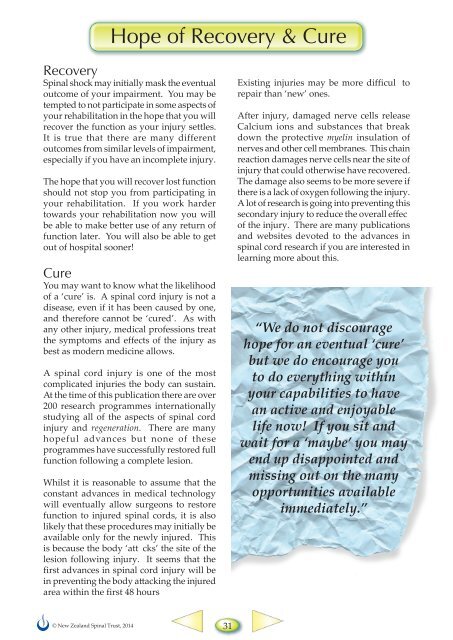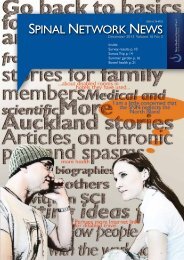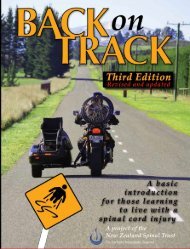o_19m515s4j1asl13rsiok91e166nh.pdf
Create successful ePaper yourself
Turn your PDF publications into a flip-book with our unique Google optimized e-Paper software.
Hope of Recovery & Cure<br />
Recovery<br />
Spinal shock may initially mask the eventual<br />
outcome of your impairment. You may be<br />
tempted to not participate in some aspects of<br />
your rehabilitation in the hope that you will<br />
recover the function as your injury settles.<br />
It is true that there are many different<br />
outcomes from similar levels of impairment,<br />
especially if you have an incomplete injury.<br />
The hope that you will recover lost function<br />
should not stop you from participating in<br />
your rehabilitation. If you work harder<br />
towards your rehabilitation now you will<br />
be able to make better use of any return of<br />
function later. You will also be able to get<br />
out of hospital sooner!<br />
Cure<br />
You may want to know what the likelihood<br />
of a ‘cure’ is. A spinal cord injury is not a<br />
disease, even if it has been caused by one,<br />
and therefore cannot be ‘cured’. As with<br />
any other injury, medical professions treat<br />
the symptoms and effects of the injury as<br />
best as modern medicine allows.<br />
A spinal cord injury is one of the most<br />
complicated injuries the body can sustain.<br />
At the time of this publication there are over<br />
200 research programmes internationally<br />
studying all of the aspects of spinal cord<br />
injury and regeneration. There are many<br />
hopeful advances but none of these<br />
programmes have successfully restored full<br />
function following a complete lesion.<br />
Whilst it is reasonable to assume that the<br />
constant advances in medical technology<br />
will eventually allow surgeons to restore<br />
function to injured spinal cords, it is also<br />
likely that these procedures may initially be<br />
available only for the newly injured. This<br />
is because the body ‘att cks’ the site of the<br />
lesion following injury. It seems that the<br />
first advances in spinal cord injury will be<br />
in preventing the body attacking the injured<br />
area within the first 48 hours<br />
Existing injuries may be more difficul to<br />
repair than ‘new’ ones.<br />
After injury, damaged nerve cells release<br />
Calcium ions and substances that break<br />
down the protective myelin insulation of<br />
nerves and other cell membranes. This chain<br />
reaction damages nerve cells near the site of<br />
injury that could otherwise have recovered.<br />
The damage also seems to be more severe if<br />
there is a lack of oxygen following the injury.<br />
A lot of research is going into preventing this<br />
secondary injury to reduce the overall effec<br />
of the injury. There are many publications<br />
and websites devoted to the advances in<br />
spinal cord research if you are interested in<br />
learning more about this.<br />
“We do not discourage<br />
hope for an eventual ‘cure’<br />
but we do encourage you<br />
to do everything within<br />
your capabilities to have<br />
an active and enjoyable<br />
life now! If you sit and<br />
wait for a ‘maybe’ you may<br />
end up disappointed and<br />
missing out on the many<br />
opportunities available<br />
immediately.”<br />
© New Zealand Spinal Trust, 2014<br />
31
















